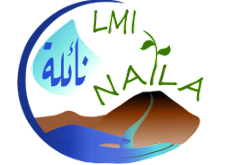Action transverse
This action aims to characterize the vulnerability of agrosystems to climate change, by designing chronicles of agro climatic drought indicators in connection with the functioning of vegetation.
First, the job is
(1) to consolidate the chronicles from the Merguellil observation network by filling in the gaps, and
(2) extending the series of observations of hydrometeorological variables over a past period.
To do this, we exploit the information from the reanalyses that provide these variables at low spatial resolution (about 30 km). This requires the adaptation of a stochastic generator of meteorological conditions (statistical methodology simulating scenarios of hydrometeorological variables) to the context of estimating water stress in semi-arid regions.
The generator allows
(1) to fill in the gaps over a period of observations and
(2) to project scenarios over a period distinct from the observation period.
This action is based on new collaborations (INRGREF, INAT, CESBIO and HSM), it mobilizes skills in climatology, statistics, hydrology, bio climatology and remote sensing, and it includes co-supervision of thesis (co-supervision INAT Tunis / UPS Toulouse).
In the medium term, methodological developments will make it possible to produce chronicles related to climate change (axis 3), and the results obtained will help decision-makers to rationalize water
Actions in detail
Contribution of remote sensing and auxiliary variables in the study of drought periods
Thesis (axes 1 & 2 of the LMI): Nesrine FARHANI (INAT/CESBIO)
Thesis directors: Zohra Lili-Chabaane (INAT) and Gilles Boulet (CESBIO)
Supervision: Zeineik Kassouk (INAT), Rim Zitouna-Chebbi (INRGREF) and Julie Carreau (HSM)
| Goals | The thesis focuses on agronomic drought, this phenomenon relates to insufficient precipitation, the difference between actual and potential evapotranspiration, and the lack of water in soils and water reserves. The thesis aims to establish a spatial and temporal monitoring of real evapotranspiration and stress indices at the two LMI sites in Tunisia: Merguellil watershed and Lebna watershed. |
| Approach/methodology | 1/ Creation of scenarios of hydro-meteorological variables (Tair, Hr, Rg, Vmoy, Pa and Precip) at a time step of 30 min 2/ Simulation of water stress maps from a soil-vegetation transfer model-atmosphere (SVAT) fed by scenarios of hydro-meteorological variables and satellite images 3/ Comparison of stress indices based on different wavelengths in terms of their ability to detect water stress of vegetation (precocity) |
| Principal results | Development and adaptation of a multi-variable stochastic generator with intraday resolution which exploits the products of reanalysis (ERA5) Application of the stochastic generator to the three stations of the Merguellil plain to obtain complete series (without gaps) Temporal extension (projection over a past period) using the stochastic generator and comparison with two bias correction methods applied to reanalyses (ERA5) |
